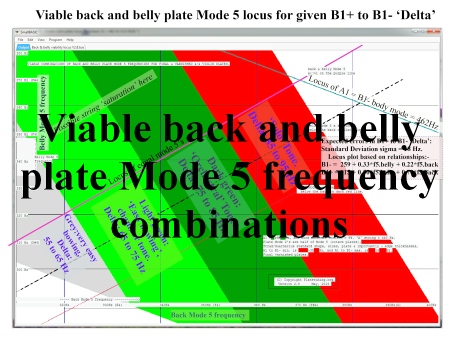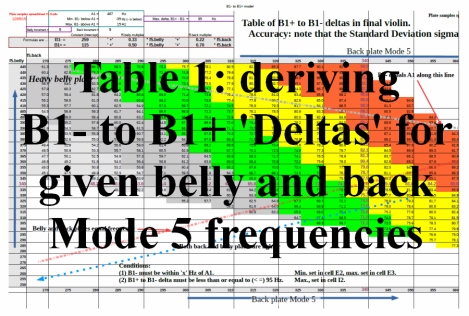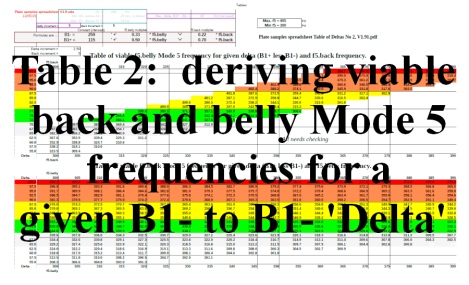|
 So to predict the ‘Delta', the frequency gap between B1- and B1+ use the chart given on the right here: click on it. So to predict the ‘Delta', the frequency gap between B1- and B1+ use the chart given on the right here: click on it.
The different ‘tones' of the violin can be chosen as shown: ranging from ‘easy bowing' for students, to ‘chamber instrument' (very responsive!), to ‘Orchestral tone', which carries well, to ‘Solo' which carries very well ..... but does require great expertise in bowing.
The Tables
Table 1 (right) allows you to choose the ‘Delta' for any given violin tone as described above. It ranges from
- ‘Easy bowing' tone (‘Delta' around 60 to 75 Hz)
- ‘Orchestra tone', (Delta' around 80 Hz, and
- ‘Solo' tone, (‘Delta' 85 to 95 Hz.
I do not recommend going above a ‘Delta' of 95 Hz Hz
Table 2 (right).
If you know either the Mode 5 of a back or belly plate then Table 2 right will give you the range of viable plate Mode 5 frequencies to go with it to give you a ‘Delta' of your choice, ranging again from ‘Easy bowing' to ‘Solo' tone.
Sensitivity
You may be able to see from the charts above that ‘Delta' (the B1- to B1+ body resonance gap) is ~3 times more sensitive to Mode 5 of the back plate as Mode 5 of the belly plate.
For this reason it is recommend that you start with a back plate and them match the belly to it!
The ‘model'.
The model to predict B1- and B1+ from the plate Mode 5 frequencies is derived by extending the work suggested in a paper by Alonso Moral (1984) outlining these relationships. It is not sophisticated.
By taking 18 violin examples where the plate Mode 5's and the final violin B1- and B1+ mode frequencies are known I simply used a method of seeking equation values that give the lowest standard deviations by successive iteration. They need to be matched to the A1 (lengthwise air) resonance.
The relationships (Mode 5's to B1+ and B1-) are shown in each of the 3 tables above: they work well, but please take note of the Standard Deviations (likely errors), as you may well have to make adjustments after assembling the violin for he first time (!), or remove the belly plate to re-adjust the thicknesses.
It looks to me as if Sr. Stradivarius set the key body resonances after completing the violin, as he only finished the edgework and inserted purfling after gluing on the belly!
The key violin body resonances are very sensitive to re-thicknessing the plates on the outsides: much more so than thinning inside, so beware!!!
A few scrapes on the outside of one or both plates can drop the body resonances quickly, and they can't be raised again!
Time for Examples :
Belly plate
TBA.
There is a Wiki page giving the relationship between frequency (Hz) and modern pitch here.
Back Plate
TBA.
What to set the Mode 5 tap tones of the plates for the various choices of tone is explained on the page ‘Platetuning 4 dummies' and the outline of how to do it is explained.
Plate weights
David Langsather gives very low plate weights of 54 gm front with bass bar, and an incredible 86 grams back. Stradivarius' bellies, with bass bar & varnish, are also typically low at 58 - 70 gm. Dr. Harris uses heavier plates, typically 65 gm front and 109 gm. back before ff's and varnish.
A Charles Davis has been in touch to tell me (Jun ‘08) about Joseph Curtin's Strad magazine article on Stradivarius front plates: found at the Strad magazine website. Jo Curtin uses a ‘stiffness number' based on f2 x weight /100,000 for each Mode separately, but there is some useful tap tone frequencies here.
|